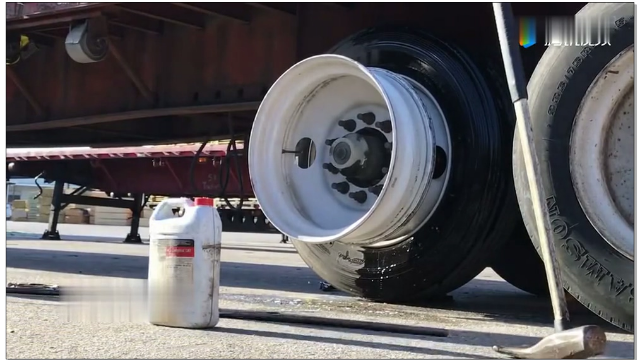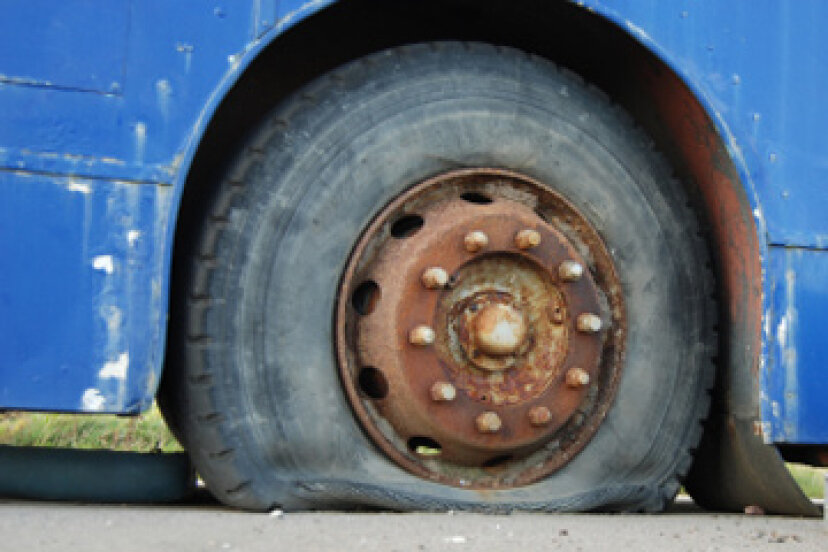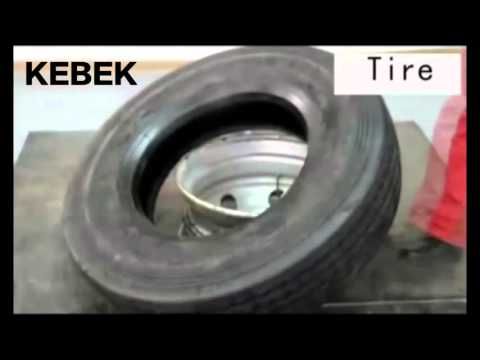If you're used to having your spare tire on your trunk, it can be quite a daunting task to remove the spare tire under a truck. But don't worry. We got you covered. We've asked automotive experts how this procedure is done so that you can get started on changing your flat tire and be back on the road in a jiffy.
Follow these steps to remove the spare tire from your truck:
Hang on so we can elaborate on the given instructions so you can remove your spare tire from your truck with no hassle. We'll also share with you how to do this task when you don't have your tire removal kit. We'll also have a short discussion on how long you can expect your spare tire to last and how far you can drive using your spare tire.
Before you continue reading, let us say we hope you find the links here useful. If you purchase something through a link on this page, we may get a commission, so thank you!
Unlike regular vehicles that conveniently have their spare tires in their trunks, pickup trucks have theirs underneath the truck bed. This is actually a genius move by manufacturers so that the spare tire won't take up valuable space on the bed of the truck. However, it makes removing the spare tire more challenging.
Don't worry because there's an efficient way of removing the spare tire without breaking your back or endangering your life. Just follow these steps. You can also watch this YouTube video for the demonstration.
 Attach the handle on the groove near the top.
Attach the handle on the groove near the top.Easy, right? You don't have to go under your truck after all!
Brand new vehicles come with a set of factory jack kits or tire removal kits to aid you in getting the spare tire off the truck. You need to familiarize yourself with these tools, so you'll know what they are used for.
The tool that you use to lower the spare tire is called the jack handle. As mentioned above, this is a long piece of tool that you need to assemble so that you can connect it with the vehicle's tire-lowering mechanism. You turn the handle counterclockwise to unfasten the tire until it reaches the ground and you can remove it from the cable and tire holder.
If you don't have this in your tool kit, it's best to buy one as soon as possible. You never know when you're going to need it. Always be prepared for what can happen on the road.
Check out this spare tire jack handle on Amazon.
In case you have a tire blowout and you don't have a jack handle with you, there are other ways for you to remove the spare under your truck. But it would still involve other tools that hopefully you've got in your tool kit.
What you need:
Steps to lower the tire:
 Make sure your car is parked properly on flat ground.
Make sure your car is parked properly on flat ground.What you need:
Steps to lower the tire:

These are just two ways for you to remove the spare tire without a jack handle. Basically, you can improvise with the tools that you've got to see which one will work best for you.
The lifespan of your spare tire will depend on its tire type. There are usually three types of spare tires: a donut, run-flat, and a matching spare tire.
A donut is also known as a space-saver or compact spare tire. This is smaller and lighter than a regular tire. In recent years, manufacturers began using donut spare tires on their vehicles to reduce cost and save valuable space since a full-sized tire takes up so much room.
Since they are more lightweight, they help improve the fuel economy and power consumption of your vehicle. However, this type of tire is made of weaker materials than traditional tires. They have a shallower tread depth which makes them more vulnerable on the road.
As such, a donut spare tire is just meant to be a temporary replacement for your worn-out tire. It has to be replaced immediately before you get yourself into trouble while using it.
A run-flat spare tire is more commonly found on newer vehicles. It is also called a zero-pressure tire. It is more durable than a donut tire. It is made of tougher materials that's why it can resist deflation even when it has been punctured.
But still, this is a temporary fix for your vehicle. You're better off having it replaced right away.
This is the most durable among the different spare tire types. It may not be made by the same manufacturer as your regular tires, but it is at par when it comes to performance on the road. As such, you can use it for a longer time after replacing your flat tire with this spare.
As such, you can use it for a longer time after replacing your flat tire with this spare.
Again, the distance and speed at which you drive using a spare tire would depend on the type of tire that you have.
Donut tires are not designed to be driven for long distances. You have to maintain a speed of 50 mph or less. This means that you cannot use this on the highway.
Since donut tires are smaller than your other tires, they have to work harder to keep up with the rest. This makes them more susceptible to damages on the road.
With a run-flat tire, you can go beyond 50 mph since it has better endurance on the road. You can drive up to 100 miles with it. This will give you more allowance to find an able auto repair shop.
Lastly, a matching spare tire can be driven similar to a regular tire. You can go at the maximum allowable speed on the road and there's no limit on the distance.
Take note though that spare tires have different speed ratings so it's best to check yours. Don't go beyond the recommended speed to avoid damaging other components of your vehicle such as the transmission. It's bad enough that you had a flat tire, you don't need the added expense of additional repairs or part replacement.
Don't go beyond the recommended speed to avoid damaging other components of your vehicle such as the transmission. It's bad enough that you had a flat tire, you don't need the added expense of additional repairs or part replacement.
Make sure you always have your tire removal kit with you so you can take off your spare tire under your vehicle without any hassle. With the right tools, this task doesn't have to be a chore.
Check out these articles for some related reading:
Does Firestone Patch Tires For Free?
20 Types Of Tires You Should Know
by Jody L. Campbell
Whether you have a flat tire on your Chevy truck that needs to be replaced or you want to install an aftermarket tow hitch, you're going to have to remove the spare tire. Mounted under the bed, the spare tire on the Chevy pickup requires connecting extension components in order to access the ratcheting mechanism and then activate it. Knowing how to remove and install a spare tire on any vehicle is always a good idea before you need to in the event of an emergency. Replacing a tire is never fun, but if you have to learn how to remove the spare tire in the process, it's just going to take longer and make the task more frustrating.
Knowing how to remove and install a spare tire on any vehicle is always a good idea before you need to in the event of an emergency. Replacing a tire is never fun, but if you have to learn how to remove the spare tire in the process, it's just going to take longer and make the task more frustrating.
Locate the spare tire and lug wrench tool kit (equipped with the Chevy truck) behind the passenger seat. On a bench seat, tilt the seat forward and move it all the way toward the front of the truck for access to the tool kit. On extra-cab Chevy trucks, you'll need to lift the rear seat upward into the raised position to access the tool kit.
Loosen the retaining bolt by turning the dial handle counterclockwise. Loosening it will allow you to slide the tool kit out from under the retaining bolt, and if necessary, remove the bolt.
Separate the pieces of the tool kit at the back of the Chevy pickup. Locate the spare tire access hole on the right side of the rear license plate. In some newer model Chevy trucks, you might need to use the ignition key to remove a locking device designed as a spare tire theft deterrent. If so, insert the key into the lock and turn the key to remove the lock. Use a flashlight to look into the access hole to learn which adapter the spare tire cable requires in order to assemble the spare tire tools correctly. You will note a square drive application, a small hook application or a security lock application. If the security lock is required, place the lock onto the end of the small hook of the assembled spare tire tool before inserting it into the access hole.
In some newer model Chevy trucks, you might need to use the ignition key to remove a locking device designed as a spare tire theft deterrent. If so, insert the key into the lock and turn the key to remove the lock. Use a flashlight to look into the access hole to learn which adapter the spare tire cable requires in order to assemble the spare tire tools correctly. You will note a square drive application, a small hook application or a security lock application. If the security lock is required, place the lock onto the end of the small hook of the assembled spare tire tool before inserting it into the access hole.
Assemble two of the spare tire tool extensions together, making sure the press-locks insert into the holes to interlock. The end of the tool must mate to the cable crank of the spare tire; this is revealed when using the flashlight.
Insert the two extensions into the access hole and turn them while pressing inward until they lock into the cable crank of the spare tire.
Retrieve the lug nut wrench. You will note a square drive in the center of the wrench. Place the square drive onto the extension tools in order to use it as an unwinding and winding device. Once locked into place, turn the lug wrench counterclockwise, lowering the spare tire from its mounted position. Continue to lower the tire to the ground until you can lift it and remove the cable flange from the hub of the spare.
To raise the spare tire, reverse the procedure and turn the spare tire tool in a clockwise motion to raise the cable.
Tips
Things You'll Need
Writer Bio
Jody L. Campbell spent over 15 years as both a manager and an under-car specialist in the automotive repair industry. Prior to that, he managed two different restaurants for over 15 years. Campbell began his professional writing career in 2004 with the publication of his first book.
Campbell began his professional writing career in 2004 with the publication of his first book.
5. If the tire is flat
) sides. If possible, do not stop the car on the roadway.
2. Stop the vehicle on level ground and apply the parking brake lever. Set up a triangular warning triangle at a sufficient distance from the vehicle (regardless of the time of day).
Note
The triangle warning triangle is located under the rear row seats of the vehicle.
If a tire burst occurs, the following basic safety precautions must be taken:
- Switch on the hazard warning light.
- Remove the vehicle from the carriageway and park it on a level and level surface in such a way that there is no risk of injury or damage to the vehicle.
- Apply the parking brake lever, put the gearbox in the reverse gear position.
- Turn off the engine.
CAUTION
For vehicles with four wheel drive, set the transfer lever to either "2H" or "4H" or "4L" to block vehicle movement. Do not leave the lever in the "N" position.
Do not change the wheel on a downhill, uphill or uneven surface, as this is very dangerous.
The jack and tool bag are located under the rear seats. Remove the wheel wrench and two levers from the tool bag. Assemble the two levers and the wheel wrench as shown.
There is an oval hole in the middle of the back of the car. Insert the end of the lever into this hole and align it with the spare wheel rim.
Insert the T-end of the lever into the T-hole in the spare wheel disc, then turn the lever counterclockwise to lower the spare wheel.
After the spare wheel is fully lowered, remove the spare wheel support plate from the underside of the vehicle and carefully remove the spare wheel.
Position the jack exactly under one of the support points shown in the figure.
WARNING
If the vehicle is only on a jack, do not get into the vehicle. For this purpose, the car should be installed on special supports.
Do not start a vehicle with a jack or jack stands.
The vehicle must not be occupied when the vehicle is jacked up or on jack stands.
CAUTION
The jack must be placed on as even and flat a surface as possible. Remove wheel cap. Turning the wheel wrench counterclockwise, unscrew all wheel nuts (in diagonal sequence) one or two turns. After lifting the car on the jack and lifting the wheel off the surface, the nuts will be unscrewed completely. Raise the vehicle carefully until the flat tire is completely clear of the ground. Remove the wheel nuts and the wheel itself.
- Wrap cloth around the work surface of a flat-blade screwdriver, insert the screwdriver into the cutout in the cap, pry and remove the cap.
CAUTION
Vehicle wheel covers are made of plastic. When dismantling them, you must proceed very carefully. It is not allowed to dismantle the caps by hand in order to avoid damage during compression.
When dismantling them, you must proceed very carefully. It is not allowed to dismantle the caps by hand in order to avoid damage during compression.
- Align the hood with the mounting surface and, by lightly tapping on the outer circumference of the hood, fix it in the installation position.
- After removing the wheel cover, use the wheelbrace to loosen the wheel nuts, but do not completely unscrew the nuts yet. Install the jack on a flat horizontal surface under the reference point closest to the wheel to be replaced, raise the car until the damaged wheel is lifted off the surface. Using a wheel wrench, completely unscrew and remove the wheel nuts, then remove the wheel itself.
- Clean the wheel hub surface, hub bolts and mounting holes in the wheel from dirt and dust, then carefully install the spare wheel.
- Install the wheel nuts and tighten them with your fingers until they stop so that the wheel does not move along the axle.
- Carefully lower the vehicle on the jack until it comes into contact with the ground. Then tighten the nuts firmly with the wheelbrace.
Then tighten the nuts firmly with the wheelbrace.
Nut tightening torque - 135 ± 15 Nm.
WARNING
When tightening the nuts, do not press the wheel wrench with your foot or hit it with a heavy object to avoid damage and overtightening of the nuts. CAUTION
The wheel nuts must be tightened evenly. Oil or grease must not be used. A carelessly or incorrectly installed and secured wheel may come loose while driving, resulting in loss of vehicle control.
To quickly change a wheel, you need to know where the spare tire is and how to get it correctly. To remove the spare wheel on the Land Cruiser Prado 150, you need to make sure that it is located under the bottom, loosen the fastening screw and lower it to the ground.
If you did not find a spare wheel in the trunk and on the back door of the car, do not rush to blame the thieves. Look under the rear bumper. You will probably find it attached to the bottom of the car.
Look under the rear bumper. You will probably find it attached to the bottom of the car.
In order to remove the spare wheel on the Prado 150, you will need an additional tool that the manufacturer supplies with the machine. It is stored in the trunk box on the right side. This is a two-piece lever that acts as an extension for the jack handle.
In the same way, you can remove the spare tire on other models in bodies of the same type, including the Land Cruiser Prado 120.
Storing a reserve under the bottom (often used by Toyota), is not familiar, but has several advantages:

If this method of storage does not suit you, you can make a Prado spare tire mount inside the trunk, which is sold at a car dealership.
Fasten it vertically on the left side to save space. Or restyle and replace the rear door of the car with a wheel-mounted version.
When the spare tire is removed, it remains to replace it with a punctured one. To do this, you will need a jack and wheel chocks. Regularly in Toyota Land Cruiser Prado they are stored in a box on the right wall of the trunk.
